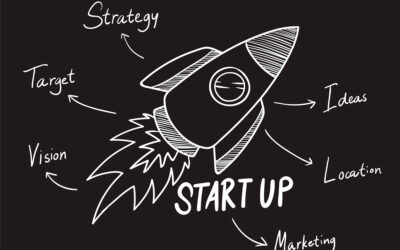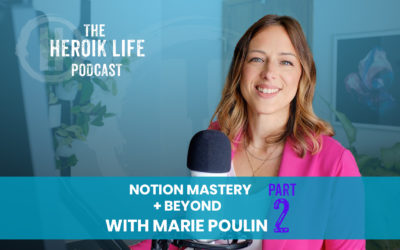Technology has enabled a global, always-on market. The speed of disruption is eroding industries that were once rock solid. Consumers have more options than ever before. In fact, they have so many options, that there are entire new industries to help them decide and cope with the overload and anxiety of choice fatigue.
The global competition, technological disruption and erosion lead to a massive response to consolidate and buy a way out of the challenges created. Companies that were caught off guard by the impact of these changes actively seek to buy not only innovative assets, but innovative processes, methods, and philosophies. They do this in order to continue to provide value for consumers, and returns for shareholders. But these acquisitions are rarely smart, and rarely result in a positive impact on the organization.
So the strategy becomes to excite and rev up the hype machine that inflates the value and promise of various start-ups and institutions of thought. Companies look to leapfrog those buying innovative startups, by creating and hyping what they claim to be be factories for innovation. Incubators and accelerators, are being built in droves by organizations that have little to no clue about the forces that drive value in the new economy, but they know how to use buzz words and bait other organizations and communities, into creating synergistic relationships based on a hype of innovation. Very few of these innovation activities and/or efforts are rooted in the exploration and experimentation of any real value creation in the 21st century. The incubators and accelerators being built in partnership with big banks, chambers of commerce, local communities, and other businesses, are busy creating…nothing…well…conversations about buzzwords at most. Yes, it’s that bad or good, depending on how you look at it.
In this behavior, there is great news and epic opportunities for organizations large and small.
-If your competitors are participating in inflating the hype or blowing these bubbles, they’re wasting a lot of resources to scare you and your shareholders, and provide a false sense of confidence to their customers, partners and shareholders.
– The majority of discussions around value creation and innovation in the 21st century amount to churning. These conversations are mostly generic, filled with useless information and very little movement and experimentation designed to create lasting value in the industry or organization.
– If competitors are not discerning and confident in their ability to read the field, they are likely buying into a firehose of big data. This information tends to be mostly filler and fluff (vanity metrics) and numbers that don’t have causal connections to returns.
– Marketing and PR types are busier than ever creating new shades of lipstick for the pigs of run-down, underperforming organizations that can’t compete with leaner, more affordable upstarts. Your competitors are spending a fortune on lipstick and messaging, avoiding addressing the gaping lack of substance in their revenue models.
All of this is great news. You should be thankful for such efforts, because even if you’ve waited to decide which transformation path to go down, you’re in a better position than those competitors spending billions on wasteful efforts. If you’re not wasting resources on these image only moves, your resources are free to truly lead with a leaner, more effective and resilient effort that is focused on value creation and not easily distracted with noise. And in the 21st century, you need a new kind of sherpa. A guide with a methodology and understanding of new paradigms of value creation and frameworks. A guide like this will help ensure you’re the discerning party building a robust and resilient organization, while gaining recognition for the effort. But before you go there, you need to understand what value creation is in the 21st century.
So what is value creation in the 21st century?
The most important trends are in how we assess and look at value these days. The linchpin, and focus of many a business should be a masterful look at the intangible value created in the industry and local revenue model.
Tangible value is usually bundled and assessed with intangible value, unless you’re selling a commodity. Many industries find themselves in a commoditized position because they fail to convince their customers that there is any intangible value at all. If you’re in a price war for example, it’s usually because the intangible value is indistinguishable from the competition.
In the post industrial Information Age, the emphasis of value is on the intangible. As a result, much of the business effort is focused on creating and differentiating this intangible value. Intangible value is subjective and hard to define but can be characterized. It includes feedback loops and feelings we get like peace of mind; the feeling of security we get when we buy a robust insurance policy, or the feeling of comfort we get from paying a premium for VIP treatment and we can rest at ease knowing we’ll be taken care of. Intangible value is also experienced when we buy more than we need or can use. When you know you’ll use 2% of the features but pay a premium for the 98% that you don’t need and aren’t likely to use, you’re paying for value of aspiration, and capacity for growth. This aspirational, intangible value, the kind that we pay for because we believe we’ll grow into using it, is very popular. It’s like buying a pair of jeans two sizes two small because we aspire to lose the weight. There’s certainly value there, but it is often non-material and purely related to experience and state of mind.
To put it mildly, Business is more intricate and complex these days. Smart companies find themselves competing and differentiating based largely on the intangible value, and there are new battlefronts and multilayered dimensions to address beyond the Don Draper 50’s era of branding that modern businesses need to address.
There is also aspirational value. Individuals and organizations make purchases based on the assumption that affiliation will bring them closer to a desired goal. This usually takes the form of the appearance of success. There is as much luxury attached to the idea of professionalism, that determines whether your company will use a $.99 app, or purchase 100 licenses of Adobe Creative Suite that costs hundreds of thousands of dollars. Somewhere in the mix of Adobe’s value proposition is the notion that they “offer the tools that successful professionals use.” The bottom line is, somewhere in the decision process, someone evaluated the tools based less on capabilities that are present, or those that will actually be used. Instead they imply peace of mind, confidence and aspirational characteristics they’d be bringing into the business, and by extension to their customers and shareholders.
In the Information Age, organizations are more transparent than ever, whether they like it or not. Customers and shareholders have faster access to more information about business than ever before. This creates new touch points for the customer that most organizations don’t notice, and often go neglected.
Here are a few questions to ask yourself, that you may find revealing:
-What role does your company culture play in your customer relationships?
-How much of your culture do your customers see and notice?
-Does what they see inspire more trust, loyalty, deeper engagement and even investment?
Leading organizations know the answers to these questions. They see the relationship between retention, loyalty, and the experience of the entire organization, especially through its most visible parts. Things like company culture, process, and management style, used to be closely held secrets of the organization, and were only truly known to insiders. Now, thanks to technology and social media, all of these are in play – shaping and influencing the customer experience.
The “Design” aspect of all of these touch points is now more important than ever. Customers expect a cohesive experience consistent with every promise and value espoused to be held by the organization. And since there is more transparency, and more contact with consumers than ever before, organizations must now have a much higher degree of operational integrity in order to hold onto and draw in customers. They can no longer get away with pretty graphics and empty slogans and value statements. And those that try, continue to flail and waste resources in the ways previously mentioned.
At the end of the day, there is a single unifying dimension and lens of value that most business aren’t even focused on in their efforts to retool and equip themselves. It is the experience. The collective interface between customer and organization; the employee and the organization; the partners and shareholders too. And those who master this lens of value, (the art of experience design) can sidestep the waste and lipstick, and create a more powerful and resilient value proposition. With this skill, one can provide more captivating tangibles and intangibles that resonate more deeply with the end users. To put it plainly, through a new discipline of Experience Design, leaders, managers and teams, can be more effective, adaptive and strategically relevant in the Digital Age.
When referring to design, most managers and executives think about marketing and branding. Indeed, the term is broad and inclusive of many ideas, but most believe the place for design traditionally happens at the end of strategic processes. This is the mindset and approach of yesteryear, and is no longer a viable approach to business. Marketers and Designers will still blow smoke to the contrary to earn your business. But if you haven’t been deploying design thinking, and experience design thinking from the top down, you are severely limiting your efforts, products, and services.
Experience Design is a new field of work for a new kind of worker, manager and leader. This term is used and abused along with other buzz words on a regular basis. Therefore, I will define it through the lens of our firm’s method and approach – Heroik Experience Design. In our view, Heroik Experience Design is a multidisciplinary, systematic approach to deploying a hybrid of design and business thinking to frame problems, build projects, and evaluate solutions to achieve an optimum mix of value for the customer, and engagement with the business.
To break it down further, traditional design tends to look at small, short term events and instances, and focused environments. In contrast, Heroik Experience Design considers a project broadly across ecosystems, over the entire lifetime of product, customer, and organization. Experience Design addresses not only the small and more nuanced aspects, but goes further to the microscopic and quantum levels, These are the rules of design physics that impact the end user value and experience.
To illustrate, where others talk about trees and forests, experience designers will discuss leaves and texture, pine needles, bugs, and air quality. Where artists address the canvas and paint, experience designers take it a step further. They care how the canvas is hung and lit, in what room it resides, in what space it is placed, in which building,and in which town. Where analysts cherry pick data and sources, we look holistically across the big picture to determine the best path forward and purposefully validate or invalidate our suppositions.
As a discipline, Experience Design requires a broad and deep understanding (more or less) of the following skillsets:
- Design Thinking
- Content Strategy
- Soft Infrastructure
- Communications
- Visual Arts (Graphic, Web, Product, etc. Design)
- Statistics
- Brand Development & Branding
- Company Culture
- New Technology
- Marketing, Public Relations
- Copy Writing
- Cognitive Neuroscience
- Psychology
- Game Theory and Gamification
- Product Development
- Product Management
- Phased GTM Planning
- Behavioral Economics
- Lean and Agile Processes
- Business Management and Operations
Those are just to name a few. If you’re team leans heavily on one, you’re often back to a siloed and narrow view of the business challenge, often relying on an outdated framework for evaluation and analysis. Why is such a background essential? A multidisciplinary approach ensures a more robust method that doesn’t favor or rest too much in one silo, but is focused instead on the customer’s perspective.
In order to run lean, you need the ability to challenge the traditional reasoning behind various schools of thought, and ask “Why is it done this way?” And if it’s your silo on the chopping block, you’re less likely to cut yourself or your team out of the equation. This is how siloed thinking persists. And In the Digital Age, there are still many business philosophies, practices and behaviors rooted in the industrial and postindustrial eras, that frankly no longer serve the organization. And yet they remain unchallenged, “because that’s the way it’s always been done.”
If that doesn’t do it for you, how about this:
According to Design Value Index, over the past decade, design led, publicly traded companies, outperformed the S&P by 228% !
To give you an idea of what successes there are to be had with an experience designer involved in the leadership team, here are a few examples:
-Slack, the simple, transformative, culture shifting communications platform, valued at over $1 billion dollars, is run by Stewart Butterfield. He is a designer with a heavy, strategic product development background and also a co-founder of Flickr.
-Starbucks founder and CEO, Howard Schultz, though not formally trained in design, is strategically focused on every touch, smell, sight and sound of the customer experience, and is intimately involved in these decisions. He is an Experience Designer and has single handedly transformed the commodity coffee business into a cultural phenomenon wherein customers pay 10x the value of the product.
– Steve Jobs, was notorious for being involved to a fault with every nuance of product development and was unapologetic about ensuring that the quality of those products were aligned and lived up to the brand promise of Apple.
When you consider how industries are scrambling to create value and differentiate intangible value in new ways, most settle on solutions that improve only the tiniest of touchpoints. Examples would include their brand, image, web presence, and graphic design. And even within those aspects, their renditions are surface level and subpar for the modern consumer.
Bottom Line:
Through properly applied design thinking and experience design, your organization can expend fewer resources than the competition while creating better products and experiences for your customers. This is true value creation that will help you stand out from the herd to be a world class organization.
LIKE THIS ? Leave a comment. Tell us what you think. HATE THIS? Leave a comment anyway, let’s troll it out in debate and productive discussion 🙂
For more information about our approach to this, check out Heroik.org, or for direct contact – email me nmcgill@getheroik.com





0 Comments